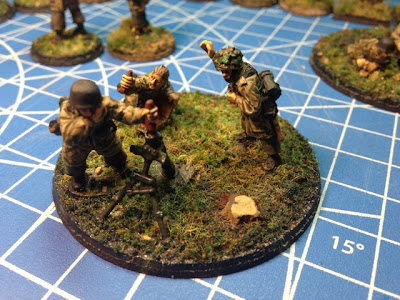All of the parts came off the "sprue" cleanly with little effort and assembled very easily. I was most impressed by the precision of the subassemblies and how well it all fit together. In total, this build took approximately one hour, during which I paused to photograph each step for this review.
 |
| The Kit |
 |
| All the parts |
First I assembled the outer walls per the instructions, then while the glue was still wet (and the walls could be adjusted) I glued the walls to the floor as seen below.
Again, while the glue on the outer walls was setting up, I glued the inner walls into the structure.
At this point, I was pleasantly surprised by how sturdy the model felt. This is clearly designed to withstand the abuse associated with wargaming and not just a static model for the display case.
I added the window as seen above. This is the one piece in the entire assembly that had a small defect. The edges of the window are nearly paper thin, and in the one corner of the window insert, the piece separated. I was able to fix it while gluing it into position, and it didn't affect the look or ease of assembly.
The door assembly and doorframe was next. I was impressed by how easy the door went together even with the very small pieces.
 |
| The fire pit |
Next, I glued the door into the frame and the fire pit to the floor. I chose to assemble the door in the closed position, but tried it both open and closed. I decided to go with closed to allow for maximum figures to be spaced inside the structure, if the scenario ever came up in a game.
Next was the roof. Here, I made one minor error; I removed all the parts without checking the lettering. It was only after I had the four parts out did I realize the two pieces creating the actual roof were slightly different size. I decided to dry fit everything to make sure I understood the assembly before gluing. All went well.
 |
| The roof before adding the thatch |
Okay, here is where I was VERY impressed... the roof section slipped perfectly onto the buildings walls. The fit was just right - nice job 4Ground!
The thatch actually comes in the three pieces needed - no measuring and cutting required.
Above, I used a disposable "acid brush" to spread the glue evenly before applying the thatch.
The roof material has a natural direction to the "thatch," and I made sure to attach it so the thatch was flowing down toward the ground.
I applied glue per the picture in the instructions for the final piece of thatch and then attached it.
Here's the completed 4Ground Late Saxon Hovel. I will wait at least 24 hours before the next step of flattening the thatch with a 50/50 water/pva mix.
This was an easy build and resulted in a table ready piece in about an hour. I will be exploring more of the 4Ground structures in the future. And, a special thanks to my best buddy, John, for giving me this one to build.
























